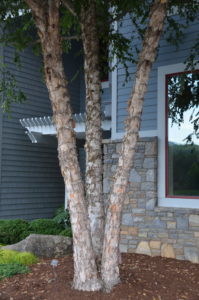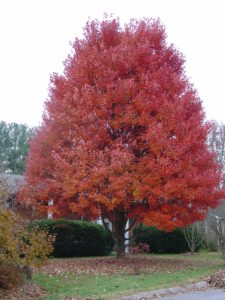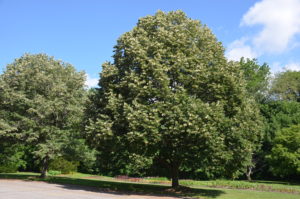Medium to large shade trees increase the value of your property. Their summer shade and wintry wind protection may also reduce utility bills by 20 to 25%. Trees attract wild birds for nesting, protection, and as a food source. Some deciduous species will brighten up the landscape with dazzling fall color. Choosing a fast growing tree, yet some may not be good option. Know the maintenance level of the tree(s) before purchasing. Is the tree susceptible to disease and/or insects? Are better resistant cultivars available? Fit the right tree to the right location.
Much of the information comes from the Morton Arboretum in Lisle IL (near Chicago) and is highly reliable. Trees are ranked by their actual growth rate the first 10 years after planting. I have added some outstanding cultivars that you should purchase.
Category 1. Fast-growing trees (at least 25 feet tall) after 10 years:
Silver Maple (Acer saccharinum)
London Planetree (Platanus x acerfolia) ‘Columbia’, ‘Yarwood’
Sycamore (Platanus occidentalis)
American Elm (Ulmus americana) ‘Washington’, ‘Princeton’, ‘Jefferson’
Category 2. Moderately fast growing trees (18 to 25 feet tall):
Hybrid Freeman Maples (Acer freemanii)
Red Maple (Acer rubrum) ‘October Glory’, ‘Red Sunset’
Sugar Maple (Acer saccharum) ‘Green Mountain’, ‘Legacy’, ‘Sweet Shadow’
River birch (Betula nigra) -‘Heritage’, ”Duraheat’
Thornless Honeylocust (Gleditsia triacanthos var. inermis)
Kentucky Coffeetree (Gymnocladus dioicus) ‘Espresso’
Sawtooth Oak (Quercus acutissima)
Shingle Oak (Quercus imbricaria)
English Oak (Quercus robur)
Pin Oak (Quercus palustris)
Little leaf Linden (Tilia cordata)
Redmond Linden (Tilia x euchlora ‘Redmond’)
Silver linden (Tilia tomentosa)
Tuliptree (Liriodendron tulipifera) ‘Little Volunteer’
Category 3. Slower growing trees (less than 18 feet tall after 10 years):
Ohio Buckeye (Aesculus glabra)
European Hornbeam (Carpinus betulus) ‘Fastigiata’, ‘Frans Fontaine’
Common Hackberry (Celtis occidentalis)
Yellowwood (Cladrastis kentukea)
Ginkgo (Ginkgo biloba) (male clones)
Ironwood (Ostrya virginiana)
Norway Maple (Acer platanoides)
Sweetgum (Liquidambar styraciflua) ‘Slender Silhouette’, ‘Happidaze’
Category 4. Medium sized landscape trees:
Trident maple (Acer buergerianum) Aeryn®
Golden raintree (Koelreuteria paniculata)
Crape myrtle (tree forms) (Lagerstroemia x) ‘Natchez’, ‘Muskogee’
Black gum, tupelo (Nyssa sylvatica) ‘Wildfire’, ‘Green Gable’, ‘Red Rage’
Japanese pagoda tree (Styphnolobium japonica) ‘Regent’
Willow oak (Quercus phellos)
Live oak (Quercus virginiana)
Bald cypress (Taxodium distichum) ‘Shawnee Brave’
Lacebark elm (Ulmus parvifolia) ‘Athena’, ‘Bosque’
Japanese zelkova (Zelkova serrata) ‘Green Vase’
Editor’s note: all ash species (Fraxinus spp.) have been delisted from the Morton Arboretum study because of their susceptibility to Emerald Ash Borer.





 Posted in
Posted in 
